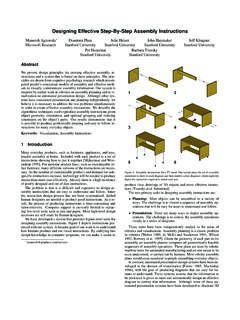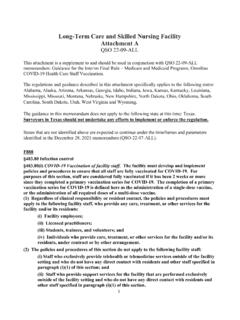Transcription of Developing Effective LISTENING SKILLS
1 Developing Effective LISTENING SKILLS CONTENTS Introduction 3 Modes of LISTENING 4 Levels of LISTENING Conversation Prompts & Probes Issue-Based LISTENING 2 INTRODUCTION Why are Effective LISTENING SKILLS important? It s simple: most of what we do or don t do (the way we act and respond to others) is based on our understanding of the messages that have been conveyed to us. In practical terms, misunderstanding can cost us time, money, credibility, and even relationships. Conversely, accurately received messages create comfort, confidence, and appreciation in the minds of our customers. There are three different modes and four different levels of Effective LISTENING SKILLS .
2 The three modes, or manners, of LISTENING are Attentive, Responsive, and Active. The four levels of LISTENING are Factual, Perceptive, Emotional, and Mixed. We ll highlight each area to help increase your LISTENING accuracy and reduce the opportunity for misunderstanding. Developing Effective LISTENING SKILLS 3 Most people do not listen with the intent to understand; they listen with the intent to reply. - Stephen Covey 3 MODES OF LISTENING ATTENTIVE LISTENERS focus on the speaker and work hard to eliminate distractions (such as ambient noise or poor delivery SKILLS ). ATTENTIVE LISTENERS are patient and let the speaker finish their thoughts without interruption.
3 This is a difficult, but essential, skill to master in order to be considered a good listener. Attentive LISTENING 4 1. Attentive LISTENING 2. Responsive LISTENING 3. Active LISTENING 3 LISTENING MODES 3 MODES OF LISTENING RESPONSIVE LISTENING demonstrates to the speaker that you re LISTENING and understanding what they re saying while encouraging them to continue talking. Responsive LISTENING 5 Nervous gestures Yawning Looking at your watch NON-VERBAL RESPONSES Smiling Appropriate facial expression Affirmative nod of the head Appropriate eye contact Minimizing distractions (turning off cell phones, etc.) Taking notes (under-utilized way to broaden the depth of LISTENING ) Leaning slightly towards the speaker VERBAL RESPONSES Uh huh I see Yes Really?
4 Occasionally paraphrasing what you ve heard Use encouraging responses: Avoid discouraging responses: 3 MODES OF LISTENING ACTIVE LISTENING is probably the most important LISTENING skill. It is active because it combines the SKILLS of LISTENING and responding without invalidating the speaker s comments, giving the speaker your personal opinion or advice, or drawing the ownership of the conversation away from the speaker. An ACTIVE LISTENER monitors the communication of a message for both content and feeling. They pay attention to what people say, how they say it, and why they re saying it. Watch for both nonverbal and verbal indicators: Active LISTENING 6 VERBAL INDICATORS Use of strong or emotional language (cursing, derogatory comments) NONVERBAL INDICATORS Tone of voice, vocal inflection, pacing, breathing/not breathing Body language (hands, posture, movements) Facial expression Emotion behind the words 3 MODES OF LISTENING Active LISTENING Once the listener feels they understand the sender s message, they paraphrase it back to the speaker to ensure understanding prior to responding with their own answer or message.
5 The listener s goal is to first understand the messenger s thoughts, feelings, and needs and then to send them back to the messenger for verification of accuracy before proceeding. When paraphrasing, be sure to use your own words rather than simply parroting back what the messenger said. You can begin paraphrase statements with: It sounds In other It is important to acknowledge or play back both the content and the feelings behind the words. Otherwise, you ll miss critical information that is important to the sender. There s no real order for restating what you ve heard. Often, it is what is most noticeable (the content or the feeling behind the words).
6 For example: As you ve said, everything is organized and ready (content), and yet you look somewhat overwhelmed by this (feeling). So, you ve recommended that the product be used for the next surgery (content), however you don t seem excited about this change (feeling). 7 4 LEVELS OF LISTENING Listeners typically pay attention to the area of communication they think is most important. However, failure to distinguish between different levels of communication can result in a lost or misinterpreted message. LISTENING LEVELS Most conversations cover four primary levels of communication: Factual: conveyed through an accounting of information and facts Perceptive: a conveyance of beliefs and thoughts, with or without regard to facts Emotive: feelings and emotions conveyed through verbal, vocal, or visual channels Mixed: conveyed through sarcasm, clich , or humor 8 Factual, Perceptive, Emotive, Mixed 4 LEVELS OF LISTENING IDENTIFYING LEVELS OF LISTENING It is important to identify the level of communication in order to accurately assess the issue and respond to the messenger.
7 Inaccurate assessment of the communication level will lead to a misinterpretation of what is being conveyed, resulting in ineffective communication. 9 4 LEVELS OF LISTENING What are the different needs or issues to pay attention to in each of the following? Your kids just dropped a vase that your wife received as a gift. You are lost in New York City. Your friend just got promoted to the job you expected. You re being deposed in a court case. A friend s father has just passed away. CONVERSATION PROMPTS & PROBES Once you ve identified the need or issue being conveyed to you, it is important to dig a little deeper to make sure you ve hit the heart of the issue.
8 While it is easiest to ask a question, too many questions can begin to feel like an interrogation. The best way to elicit more info, and thereby clarify and issue, is to prompt the speaker using prompts and probes: Clarifying Content 10 Used in combination with paraphrasing SKILLS , prompts and probes create the best-case scenario a conversation firmly entrenched in the speaker s court with an abundance of information being conveyed, paraphrased, and clarified. Tell me Why do you say that? For example? How so? And? Then? Such So? Because? ISSUE-BASED LISTENING Amidst the different types of LISTENING and things to watch for during a conversation, learning to decipher a message is a critical skill set to develop.
9 Consider the following, pulled from Microsoft s Interview Questions, to illustrate how to identify issues in the midst of extended conversation: 11 To the untrained ear this sounds complex, if not ridiculous. The trained listener, however, has the capacity to hone in on the issues despite all the extra verbiage. Imagine you are standing in front of a mirror, facing it. Raise your right hand. Look at your reflection. When you raise your left hand your reflection raises what appears to be his right hand. But when you tilt your head up, your reflection does too, and does not appear to tilt his/her head down. Why is it that the mirror appears to reverse left and right, but not up and down?
10 By simply LISTENING for the specific helper words, such as who, what, when, where, why, how, and other interrogator words such as did, could, should, can, etc., the listener gains insight into the true issue and question behind the issue. In the previous paragraph, none of the helper words occur until the last phrase of the sentence. The word why signals the listener that the issue immediately follows. ( Why is it that the mirror reverses left and right, but not up and down? ) But that is only part of the skill set. By synthesizing and briefly conveying the gist of the entire paragraph, and then adding the paraphrased question to the end, the listener demonstrates the capacity to understand and define the issue and question through reflective playback.


